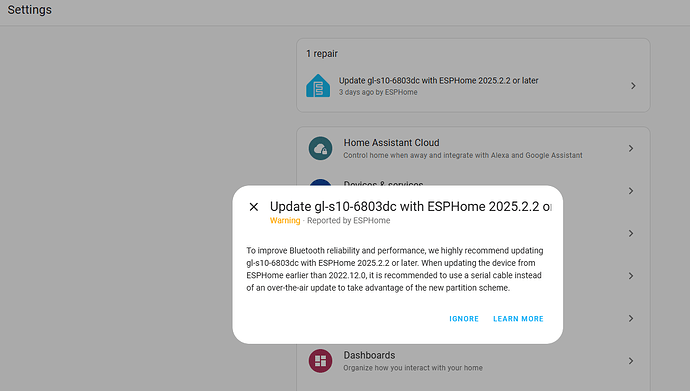Bonjour,
Me concernant, le matériel était livré avec une version ESPHome pas a jour
Update gl-s10-6803dc with ESPHome 2025.2.2 or later
Warning ⸱ Reported by ESPHome
To improve Bluetooth reliability and performance, we highly recommend updating gl-s10-6803dc with ESPHome 2025.2.2 or later. When updating the device from ESPHome earlier than 2022.12.0, it is recommended to use a serial cable instead of an over-the-air update to take advantage of the new partition scheme.
Je ne suis pas expert ESPHome, mais j’ai réussi a le mettre a jours en OTA, si ca peut servir a quelqu’un…
- J’ai installé le module complementaire « ESPHome Device Builder ».
- J’ai créer un device en ajoutant mon SSID et mot de passe associé
J’ai utilisé ce YAML :
esphome:
name: gl-s10-bt-proxy
friendly_name: Bluetooth Proxy
name_add_mac_suffix: true
project:
name: gl-s10.bluetooth-proxy
version: "2.1"
# turn on Power LED when esphome boots
on_boot:
then:
- output.turn_on: power_led
esp32:
board: esp32doit-devkit-v1
framework:
type: esp-idf
# Enable logging
logger:
# Enable Home Assistant API
api:
encryption:
key: "**API KEY Généré**"
ota:
- platform: esphome
password: "**Mot de passe Généré**"
wifi:
ssid: !secret wifi_ssid
password: !secret wifi_password
manual_ip:
static_ip: **IP**
gateway: **gateway IP**
subnet: **mask**
dns1: **Tes DNS**
# Enable fallback hotspot (captive portal) in case wifi connection fails
ap:
ssid: "Gl-S10 Fallback Hotspot"
password: "Mot de passe Généré"
dashboard_import:
package_import_url: github://blakadder/bluetooth-proxies/gl-s10_v2.yaml@main
esp32_ble_tracker:
scan_parameters:
interval: 1100ms
window: 1100ms
active: true
#
# The LED is disabled for ESPHome 2023.6.0+ since we do not
# decode the advertising packets on device anymore, and adding
# the LED blink would force the device to decode the packets
# just to blink the LED.
#
# Bluetooth LED blinks when receiving Bluetooth advertising
# on_ble_advertise:
# then:
# - output.turn_on: bluetooth_led
# - delay: 0.5s
# - output.turn_off: bluetooth_led
bluetooth_proxy:
active: true
button:
- platform: safe_mode
name: Safe Mode Boot
entity_category: diagnostic
## DEVICE SPECIFIC CONFIGURATION
# network LED (white one) configured as status led
status_led:
pin:
number: GPIO32
inverted: true
# button on the side labeled RESET
binary_sensor:
- platform: gpio
pin:
number: GPIO33
inverted: true
name: "Reset Button"
# output settings for LED's marked Power and Bluetooth
# power LED use: see code line 15
# bluetooth LED use: see code line 60
output:
- platform: gpio
pin: GPIO14
inverted: true
id: power_led
- platform: gpio
pin: GPIO12
inverted: true
id: bluetooth_led
# since these pins are broken out inside and labeled as I2C pins they're configured here
i2c:
sda: 15
scl: 13
scan: true
- Ensuite, il faut lancer l’installation du firmware, c’est assez long
- Et Home Assistant vous demandera la nouvelle API key

